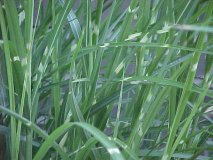| J C PLANTS LLC | HOMEPAGE |
| Telford, Pennsylvania | Perennials |
| Telephone: (267) 371 - 3050 | Grasses |
 Miscanthus sinensis 'Strictus'
Miscanthus sinensis 'Strictus'
| Common name | Porcupine grass |
| Hardiness Zone | 5 - 9 |
| Sun | Full sun - part shade |
| Soil | moist / rich |
| Flower color | Reddish-brown |
| Bloom time | August - February |
| Height | 6 to 7 feet |
| Spread | 4 feet |